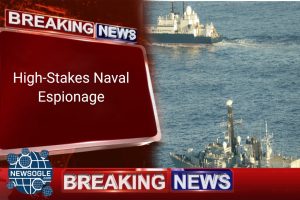
Introduction: The Escalation of Directed Energy Warfare
A dangerous new escalation in naval confrontation has been reported, involving a Russian intelligence gathering vessel using high-powered lasers to temporarily blind military pilots operating close to the spy ship. This incident, reported by The Telegraph, has raised serious concerns across NATO allies regarding the safety of their personnel and the weaponization of Directed Energy Weapons in international waters.
The brazen act suggests a calculated attempt by the Russian Spy Ship crew to interfere with routine surveillance operations, marking a significant breach of international safety protocols and elevating the risk of accidental conflict.
Details of the Laser Blinding Attack
The incident involved a specialized Russian intelligence vessel, whose exact location remains classified but was operating in a region frequently monitored by allied forces. The attack was specifically targeted at the cockpits of military aircraft conducting overhead surveillance missions.
- Targeting Method: The high-powered laser beam was reportedly aimed directly at the aircraft’s cockpit, designed to disorient and temporarily incapacitate the Military Pilots and aircrew.
- Safety Risk: The use of lasers against aircraft is inherently dangerous, posing an acute threat to flight safety, especially during critical maneuvers like approach or departure, and risking permanent damage to the pilots’ vision.
- Intent: Experts suggest the laser attack was less about permanently disabling the aircraft and more about disrupting sensitive electronic and optical sensors while demonstrating the ship’s advanced Laser Warfare capabilities.
The Vessel: A Hub of Naval Espionage
The Russian vessel implicated in the incident is typically classified as a state-of-the-art intelligence ship, designed not for direct combat but for electronic warfare (EW), monitoring, and data collection.
These ships are equipped with sophisticated arrays capable of intercepting communications, tracking radar signatures, and now, potentially deploying directed energy systems. The use of blinding lasers confirms the increasing technological sophistication—and aggression—of Russia’s naval operations near foreign assets. This tactic falls squarely within the spectrum of non-lethal, yet highly provocative, Naval Espionage activities.
Geopolitical and Legal Implications
The deployment of anti-personnel lasers is globally recognized as a grave act due to the direct threat to human life and safety.
- Violation of Protocol: Attacking the crew of an aircraft operating legally in international airspace is a severe breach of international maritime and aviation safety standards.
- Potential for Escalation: Such hostile acts create an extremely tense operational environment, increasing the chance that a pilot might mistake a laser attack for a more serious threat and respond with defensive measures, potentially triggering a military confrontation.
- Legal Debate: The use of such weapons is subject to various international treaties regarding the prohibition or restriction of certain conventional weapons, particularly those that cause unnecessary suffering or indiscriminate harm. This incident reignites the debate over regulating non-lethal, high-energy weapons.
Conclusion: A Dangerous Precedent
This Laser Blinding Attack by the Russian spy ship sets a dangerous precedent for confrontation in international waters. As military assets globally continue to rely on advanced sensors and crew vision, the deployment of blinding lasers offers an asymmetrical way for adversaries to interfere with surveillance and intelligence gathering.
Allied nations are expected to issue strong diplomatic condemnations and may implement new countermeasures to protect their Military Pilots Safety from future directed energy threats, ensuring their freedom of navigation and surveillance remains uncompromised.

Aleda Kawis is the Professional Journalist and serving in the field since 2012. She keeps extensive experience as investigating journalist and media influencer.




